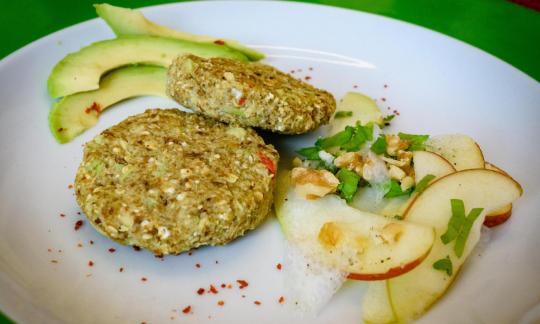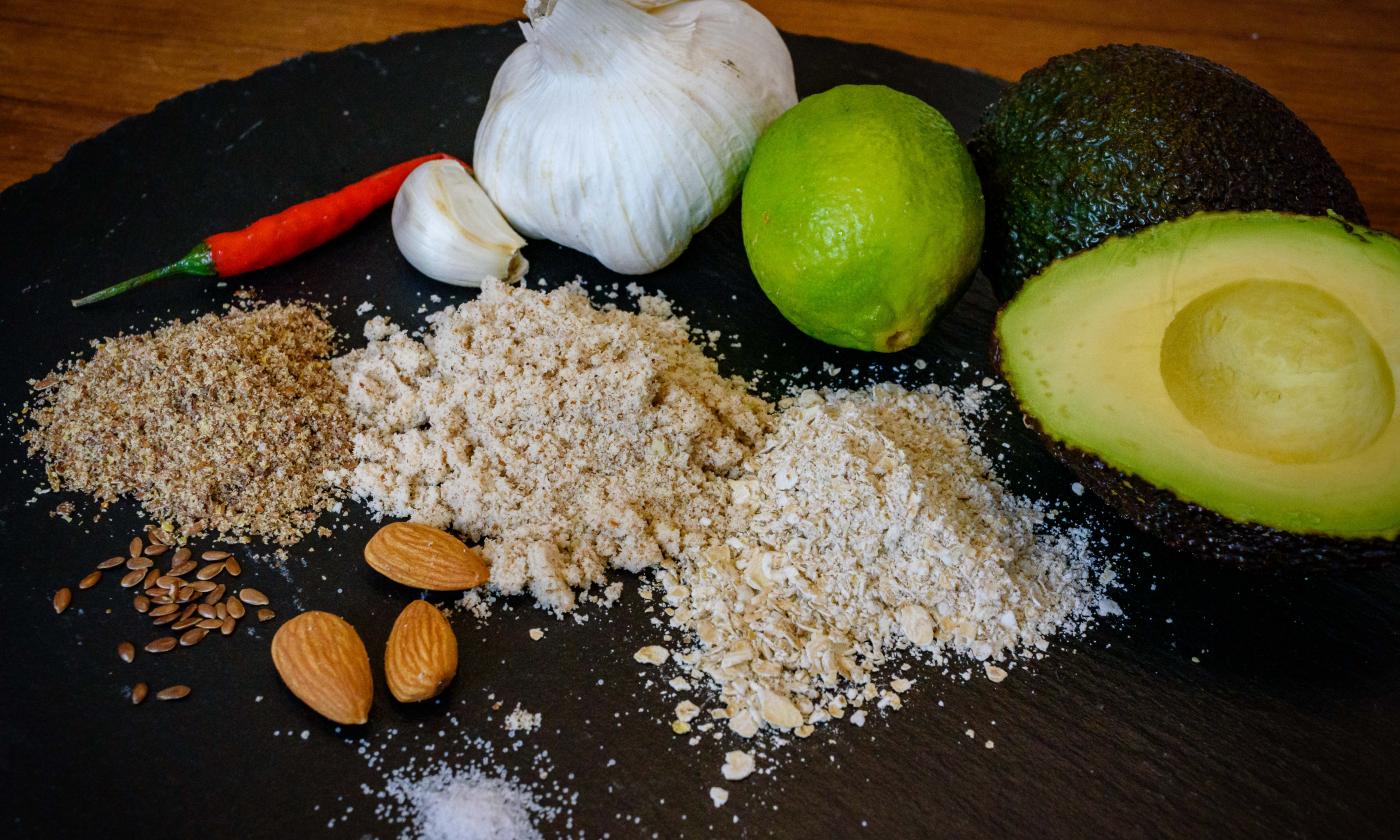Raw vegan avocado-almond patties with oat flakes
raw-vegan
Ingredients (for servings, )
| 2 ⅛ oz | Almonds (sweet almonds), raw |
| 1 oz | Linseed, raw, organic? (golden linseed, flax) |
| 2 ⅔ oz | Oat flakes (raw?, organic?) |
| 2 cloves | Garlic (organic?) (0.21 oz) |
| 1 tbsp | Lime juice (raw?, organic?) (0.25 oz) |
| ½ | Chili peppers, red, raw (organic?) (0.09 oz) |
| 1 | Avocados, raw (organic?) (7.1 oz) |
| 1 dash | Table salt (table salt, raw?, organic?) (0.01 oz) |
Equipment
- garlic press
- coffee grinder, electric
- citrus juicer (lemon squeezer)
- shredder
Type of preparation
- chop or grind
- food preparation without heating
- squeeze
- remove the skin
Preparation
preparation of the patties
Grind the almonds and linseed (in 2 steps, depending on the capacity of the machine). Roughly grind the oat flakes. Peel and press the garlic. Squeeze the lime. Finely chop half the chili pepper. Put everything in a bowl.Caution: Raw garlic has a very intense taste and smell. If you are sensitive to this, minimize the amount or leave it out altogether.
Halve the avocado and remove the pit. Remove the skin and mash the flesh with a fork. Mix everything together to form a mass and season with salt. Form the mass into patties of equal size. If the mass is too soft, you can add a little more oat flakes.
The quantities are calculated so that each person receives 2 patties.
Serve
You can serve the patties straight away or warm them up slightly in the oven at the lowest heat. Serve the patties with a salad or as finger food wrapped in a lettuce leaf.As a non-raw vegan alternative, you can also fry the patties in a pan.
|
Nutritional Information per person
Convert per 100g
|
2000 kcal | |
|---|---|---|
| Energy | 375 kcal | 18.8% |
| Fat/Lipids | 26 g | 36.7% |
| Saturated Fats | 2.8 g | 14.2% |
| Carbohydrates (inc.dietary fiber) | 31 g | 11.4% |
| Sugars | 1.8 g | 2.0% |
| Fiber | 12 g | 49.2% |
| Protein/Albumin | 11 g | 21.7% |
| Cooking Salt (Na:61.5 mg) | 156 mg | 6.5% |
| Essential micronutrients with the highest proportions | per person | 2000 kcal | |
|---|---|---|---|
| Fat | Alpha-Linolenic acid; ALA; 18:3 omega-3 | 2.4 g | 119.0% |
| Min | Manganese, Mn | 1.7 mg | 86.0% |
| Min | Copper, Cu | 0.56 mg | 56.0% |
| Vit | Vitamin E, as a-TEs | 6.7 mg | 56.0% |
| Prot | Tryptophan (Trp, W) | 0.14 g | 55.0% |
| Fat | Linoleic acid; LA; 18:2 omega-6 | 4.7 g | 47.0% |
| Elem | Phosphorus, P | 301 mg | 43.0% |
| Vit | Vitamin B9, B11 (Folate, as the active form of folic acid) | 80 µg | 40.0% |
| Elem | Magnesium, Mg | 148 mg | 39.0% |
| Prot | Threonine (Thr, T, irreversibly transaminated) | 0.34 g | 37.0% |
Detailed Nutritional Information per Person for this Recipe
The majority of the nutritional information comes from the USDA (US Department of Agriculture). This means that the information for natural products is often incomplete or only given within broader categories, whereas in most cases products made from these have more complete information displayed.
If we take flaxseed, for example, the important essential amino acid ALA (omega-3) is only included in an overarching category whereas for flaxseed oil ALA is listed specifically. In time, we will be able to change this, but it will require a lot of work. An “i” appears behind ingredients that have been adjusted and an explanation appears when you hover over this symbol.
For Erb Muesli, the original calculations resulted in 48 % of the daily requirement of ALA — but with the correction, we see that the muesli actually covers >100 % of the necessary recommendation for the omega-3 fatty acid ALA. Our goal is to eventually be able to compare the nutritional value of our recipes with those that are used in conventional western lifestyles.
| Essential fatty acids | per person | 2000 kcal |
|---|---|---|
| Alpha-Linolenic acid; ALA; 18:3 omega-3 | 2.4 g | 119.0% |
| Linoleic acid; LA; 18:2 omega-6 | 4.7 g | 47.0% |
| Essential amino acids | per person | 2000 kcal |
|---|---|---|
| Tryptophan (Trp, W) | 0.14 g | 55.0% |
| Threonine (Thr, T, irreversibly transaminated) | 0.34 g | 37.0% |
| Phenylalanine (Phe, F) | 0.56 g | 36.0% |
| Isoleucine (Ile, I) | 0.43 g | 34.0% |
| Valin (Val, V) | 0.53 g | 33.0% |
| Leucine (Leu, L) | 0.77 g | 32.0% |
| Lysine (Lys, K, irreversibly transaminated) | 0.45 g | 24.0% |
| Methionine (Met, M) | 0.15 g | 16.0% |
| Vitamins | per person | 2000 kcal |
|---|---|---|
| Vitamin E, as a-TEs | 6.7 mg | 56.0% |
| Vitamin B9, B11 (Folate, as the active form of folic acid) | 80 µg | 40.0% |
| Vitamin B1 (Thiamine) | 0.37 mg | 34.0% |
| Vitamin B2 (Riboflavin) | 0.37 mg | 27.0% |
| Vitamin B5 (Pantothenic acid) | 1.4 mg | 24.0% |
| Vitamin B6 (pyridoxine) | 0.30 mg | 22.0% |
| Vitamin K | 15 µg | 20.0% |
| Vitamin B3 (Niacin) | 2.5 mg | 16.0% |
| Vitamin B7 (Biotin, ex vitamin H) | 6.7 µg | 13.0% |
| Vitamin C (ascorbic acid) | 9.3 mg | 12.0% |
| Vitamin A, as RAE | 5.1 µg | 1.0% |
| Essential macroelements (macronutrients) | per person | 2000 kcal |
|---|---|---|
| Phosphorus, P | 301 mg | 43.0% |
| Magnesium, Mg | 148 mg | 39.0% |
| Potassium, K | 657 mg | 33.0% |
| Calcium, Ca | 104 mg | 13.0% |
| Sodium, Na | 62 mg | 8.0% |
| Essential trace elements (micronutrients) | per person | 2000 kcal |
|---|---|---|
| Manganese, Mn | 1.7 mg | 86.0% |
| Copper, Cu | 0.56 mg | 56.0% |
| Zinc, Zn | 2.4 mg | 24.0% |
| Iron, Fe | 2.8 mg | 20.0% |
| Selenium, Se | 11 µg | 20.0% |
| Fluorine, F | 5.7 µg | < 0.1% |
| Iod, I (Jod, J) | 0.45 µg | < 0.1% |
These raw vegan avocado-almond patties with oat flakes and flax seeds are healthy, delicious and quick to prepare.
Serving information: The specified amount for 3 portions makes 6 medium-sized patties and is sufficient for 3 people as a side dish, for example with a salad, such as the parsley salad with tomatoes and lemon juice or the radish salad with apple and lime dressing.
Nutritional profile: According to GDA guidelines, one portion of this recipe covers more than the average daily requirement of omega-3 fatty acids. The essential trace element manganese is covered by over 75% and copper and vitamin E are covered by over 50%. In addition, the patties contain a good ratio of omega-6 to omega-3 fatty acids at 2:1, which clearly complies with the recommended maximum ratio of 5:1.
Read more at: Vegans often eat unhealthily. Avoidable nutritional errors.
Almonds: Sweet almonds are ideal as a snack, in muesli ( pea muesli), or as a topping for salads. Sweet almonds contain relatively high levels of vitamin E and vitamin B2 (riboflavin) and, like other nuts, are rich in manganese.
Flaxseed: Flaxseed has a slightly nutty taste and a fat content of 40%. It contains around 50% of the polyunsaturated omega-3 fatty acid alpha-linolenic acid (ALA), making it the highest concentration of omega-3 fatty acids of all known vegetable oils.
Oatmeal: Oatmeal has a high protein content and contains many essential amino acids. It is also rich in vitamins and minerals, although the vitamin content may be reduced depending on the treatment (heating). This recipe can only be accepted as raw food if you use raw quality oatmeal.
Avocados: Avocados have a higher fat content than many other well-known fruits and vegetables. They are also rich in potassium and unsaturated fatty acids, although the ratio of LA:ALA is not optimal at 15:1. For information on preventing browning and storage, see Tips.
Oats and gluten: Those who suffer from gluten intolerance (celiac disease) are only intolerant to gliadin, not glutenin. Those affected must therefore avoid classic grains such as wheat, but can eat oatmeal to a certain extent. In this case, however, it must not only be ensured that the oats are not contaminated with wheat and other grains containing gluten, but they must also be specially cleaned. Corresponding oats are available in stores as gluten-free oats.
Processing avocados: It is advisable to process avocados immediately after cutting them, otherwise they will turn brown. The cut causes a break in the affected cell walls, which exposes the released ingredients to the oxidation process. This in turn causes the flesh to turn brown.
Prevent browning: Avocados will not turn dark if you moisten them with lemon or lime juice.
Make your own oat flakes: To do this, use oat grains and crush them in a flake crusher. It is not necessary to soak them beforehand. However, you should use freshly pressed oat flakes quickly, as they can taste slightly bitter due to the subsequent oxidation process with oxygen.






